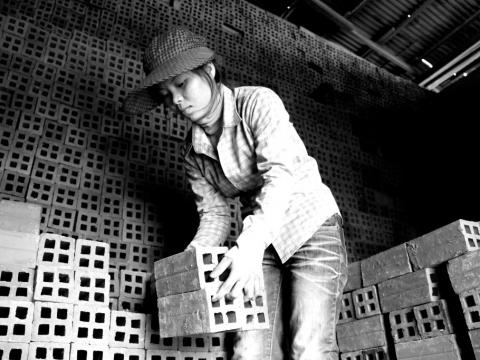Op-Ed: How businesses can take a stand against child labour

By Leen Decadt, World Vision’s Child Protection Regional Adviser, East Asia
Headlines like these are often perceived as ‘old’ news or déjà-vu’s.
“Human Rights Watch has lashed out at European retail giants over ‘discriminatory labour conditions’ in Cambodian factories, most of which exploit young women. HRW claimed in its report that one of the retailers, H&M, uses child labour”. (March 2015)
“Walmart accused of using child labour at shrimp plant in Thailand”. (June 2013)
“Apple has discovered multiple cases of child labour in its supply chain, including one Chinese company that employed 74 children under the age of 16, in the latest controversy over the technology giant's manufacturing methods”. (January 2013)
After decades of well-articulated strategies, policies and campaigns, ending child labour remains a daunting challenge. In Asia and the Pacific, the International Labour Organization states there are 77.7 million children involved in child labour as of 2013. These are children whose education, development and future livelihood have been threatened or denied. They are working to produce goods we consume.
What are we missing? Is there a more efficient way to take action against child labour?
There is a critical piece of the puzzle that’s often ignored. We need to involve businesses.
When we open this window of opportunity, by partnering with businesses that recruit young children into their supply chains, we acknowledge the reasons for child labour.
To better address the issue, we have to understand the motivation of employers to recruit children.
Poverty and the need for extra household income is a root cause that forces children into full-time work. We also must take into consideration other factors that cause child labour too – the lack of access to adequate schools and childcare, migration and the lack of parents’ understanding of the hazards of child labour. Other extraordinary factors can also play a role in the reason why children work, including the necessity to cope with disasters and financial shocks.
Indeed, the issue is complex and there is no silver bullet solution.
To better address the issue, we have to understand the motivation of employers to recruit children. Often, businesses seek cheap labour to increase maximum profit. They take advantage of children’s weaker negotiating power and try to offer inadequate work conditions. Sometimes, the availability of adult labour at peak seasons might be insufficient. Other times, there might be a demand for special skills; child’s fingers and their smaller bodies are perceived to be better for certain tasks. Girls are believed to be more docile workers.
But in this globalized era even the most responsible international businesses are facing an ethical dilemma: How does a company address the presence of child labour in its supply chain? And how do companies cope in locations where child labour is relatively common and where there is evidence that removing income-generating opportunities will push children into deeper poverty?
It is not enough for a company to dismiss children from the workplace. It may leave them vulnerable to more hazardous work such as prostitution or begging. When families don’t have income from their children’s work, it could negatively impact their health and well.
For a company to ensure the responsible elimination of child labour within their supply chains, it should first consider complying with international standards and national laws on child labour. These laws aim to protect children and establish minimum age restrictions, paying particular attention to hazardous work.
When child labourers are removed from the workplace, these children require special attention and care so that they can lead a normal life again.
Companies should respect child rights principles, based on honest assessments of the impact of recruiting child labourers on the society they work in. Training of employees, subcontractors and business partners should foster awareness of the shared responsibility and accountability to stop child labour, including a feedback mechanism to detect child labour. Contracts and partnership agreements should also explicitly prohibit child labour.
But caution is urged.
When child labourers are removed from the workplace, these children require special attention and care so that they can lead a normal life again. Steps need to be taken to ensure these children do not re-enter the workforce. These children need to gain access to schooling or vocational training, appropriate for their age and situation.
Because child labour is complex, businesses cannot tackle this issue in isolation. It requires a multi-faceted response from a wide range of stakeholders, including children, communities, governments, businesses and civil society. By involving children and youth, practical and implementable strategies can be identified and implemented.
While the responsibility of enforcing child labour legislation lies with national governments, strong collaboration at the grassroots level is necessary. Better understanding by parents and communities of the importance to invest in children’s education and their future is key, even if the matter is still highly sensitive.
It is also crucial that businesses link up with organizations to address child labour. One innovative partnership model with the corporate sector, successfully implemented by the Indian NGO MVFoundation, created ‘Child Labour Free Zones’. During the last two decades, more than one million children out of work have been (re)integrated into formal, full-time schools.
For a child-focused organisation like World Vision, the corporate sector should be a natural partner when establishing livelihood enhancement projects and strategies.
Businesses play a particular role in the child protection system and in interventions to reduce exploitation.
After all, school is the best place to work!